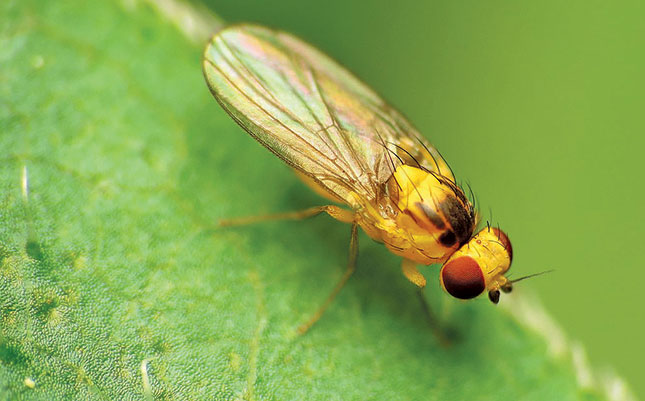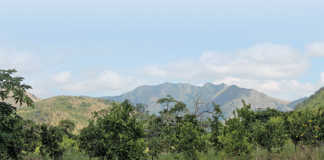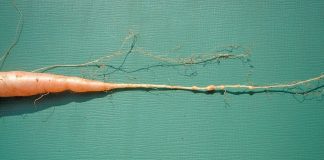
Photo: Katja Schulz
The following are some of the main tomato pests encountered in South Africa:
African bollworm (Helicoverpa armigera)
The bollworm is a major pest of many crops. On tomatoes, the larvae feed mainly on the flowers and fruit, and can cause huge losses if not controlled. The moth lays creamy-white eggs of about 0,5mm in diameter singly on the flowers and leaves. They hatch within three to five days under good conditions. The young caterpillars are hairy, and vary from black to dark beige in colour.
When fully grown (after two to three weeks), the larvae are up to 40mm long, with a characteristic broad white to pale yellow stripe on either side of the body and small black spots on the upper side. Mature larval colours range from shades of green and reddish yellow, to reddish brown and black. The underside is greyish white.
Pupation takes place in the soil. The adult moth has a wingspan of 40mm, and a body length of 18mm. The forewings have two characteristic brown markings, while the hindwings have two distinct pale spots.
In the warmer parts of KwaZulu-Natal, bollworm is present throughout the year, although populations are smaller during the cooler months (with temperatures below 18°C).
Cutworm (Agrotis spp)
Cutworms feed at night and do substantial damage by cutting off the stems of young plants at or near ground level. During the day, cutworms can be found just below the surface of the soil next to the damaged plants.
The caterpillars, which may reach a length of up to 35 mm, are usually greasy-looking, and grey to dark brown or almost black in colour, with several black tubercles (bumps) on each segment.
The moth has brown or greyish forewings, and light brown hindwings.
Plusia looper (Chrysodeixis acuta)
These caterpillars are pale green, with a narrow white stripe along each side, and grow to a length of about 30mm. They move around by arching their backs as they propel themselves forwards.
The young larvae feed on the undersides of leaves, skeletonising them. Older larvae attack the fruit, eating shallow and often extensive cavities in them.
The larvae pupate in frail cocoons. The forewings of adult moths are patterned with various shades of brown, and there are two distinct, oval, yellow spots near the middle of each wing. The wingspan is approximately 30mm.
American leaf miner (Liriomyza trifolii)
The larvae, which are bright yellow, make narrow, meandering tunnels (mines) between the upper and lower surfaces of leaves, leaving thin, black trails of excrement along the insides.
These mines may join up when infestation is severe. Damage can be serious enough to affect fruit set, and the incidence of sunburn also increases.
Adult flies are approximately 2mm long. They have pale, brownish-yellow undersides and black upper parts, with a yellow spot between the wings.
Leaf miner/potato tuber moth (Phthorimaea operculella)
The larvae are small caterpillars, which grow to a length of 12mm. They are a pale, creamy grey when young and become greenish-white or pink when older, with dark brown heads.
The moths are silvery grey or silvery brown, with faint, dark speckles on the wings. They are about 8mm long with a 15mm wingspan.
The caterpillars make irregular channels inside the leaves, and leave brown spots on the surface. They sometimes also mine the stems. Breeding takes place all year round, slowly in winter but rapidly in summer, when a generation can emerge in less than a month.
Aphids (Several types, mainly Myzus persicae)
The green peach aphid (M. persicae) is arguably the most important tomato pest in USDASouth Africa. It is a soft-bodied, slow-moving insect between 1,5mm and 2,5mm in length, with long, spindly legs, and may be winged or wingless.
Aphids, which are sap-sucking insects, have a wide host range and are present throughout the year. The direct damage they cause is less important than their role as vectors of virus diseases.
Red spider mite (Tetranychus spp)
The female is brownish-red, roughly oval, up to 0,5mm long, and has eight legs. The pest is most numerous in hot, dry weather, with numbers frequently declining after rain.
Populations can swell dramatically under favourable conditions, especially if their natural enemies are harmed by the use of certain pesticides. Resistance to specific products is common and often develops rapidly.
Red spider mites prefer to feed on the lower sides of the leaves, but as populations increase, they spread over the entire plant. Leaves may turn yellow, become bronzed and dry out.
Rust mite (Aculops lycopersici)
The rust mite is minute (about 0,2mm long) and torpedo-shaped, with a cream to orange-yellow body. The first sign of damage is curled-up lower leaves, which show a silvery gloss on their lower surfaces. Later, the leaves become bronzed, wither and eventually die. Stems become purplish-brown. Fruits become rusty brown and coarse, with surface cracking.
Erinose mite (Eriophyses lycopersici)
These microscopic mites cause the formation of dense patches of fine, white hairs on the younger leaves and stems. The pest is generally confined to tropical and subtropical areas.
Thrips (Several types, mainly Thrips tabaci)
These are small, quick-moving insects, about 1mm to 2mm long, torpedo-shaped, and yellowish in colour. They feed on flowers and young fruit by rasping the surfaces and sucking the sap from the broken cells.
This results in blossom drop and scarring of the fruit, with some malformation of the leaves.
The pest is most important as a vector of kromnek (spotted wilt virus), a serious disease of tomatoes and potatoes.
Nematodes (Several types, mainly Meloidogyne spp)
A number of nematode species can attack tomatoes. They are generally more prevalent in sandier soils and during warm conditions, with numbers reaching a peak in midsummer.
The root-knot nematodes (Meloidogyne spp) are probably the most important that affect tomatoes. They attack the roots of the plant, causing galls to develop and reducing the size and efficiency of the root systems. As a result, plant growth is stunted, fruit set reduced, and yields and quality adversely affected.
Plants show symptoms similar to those of water stress and may sometimes wilt and die, even in the presence of adequate soil moisture. Symptoms are more pronounced in certain patches of the land than others.
Control
Many pesticides are registered for use with tomatoes. Speak to your chemical supply representative or extension officer for advice on which kind is best for your crop. Always try to use pesticides that do not harm beneficial predator insects; if there are enough of these on your land, you may not need to use pesticides at all.
Source: Retrieved from www.kzndard.gov.za/images/Documents/Horticulture/Veg_prod/tomato.pdf.










